Can you safely drink tap water in Mexico? No, you generally cannot drink tap water in Mexico due to potential contamination in regional water delivery, household plumbing, and storage systems. For LGBTQ+ travelers and those interested in Mexican culture, understanding water safety is crucial for a healthy and enjoyable visit, and gaymexico.net is here to help you navigate the essentials. Discover reliable tips and insights to stay safe and connected with the LGBTQ+ community in Mexico, exploring alternatives like bottled water and filtration systems for a worry-free experience.
Table of Contents
- Why Can’t You Drink The Water In Mexico?
- Do Local People Drink Tap Water?
- Do Mexican Houses Have Filtration Systems?
- Where Can You Buy A Bottle of Water In Mexico?
- Will Ice Make Me Sick in Mexico?
- Can I Make Coffee With Tap Water In Mexico?
- Can I Brush My Teeth With Tap Water In Mexico?
- Can I Drink Tap Water In A Hotel Room In Mexico?
- Do Restaurants In Mexico Serve Tap Water to Customers?
- Final Thoughts On Why You Can’t Drink Tap Water In Mexico
- FAQ
1. Why Can’t You Drink The Water In Mexico?
You cannot drink tap water in Mexico due to potential contamination in regional water delivery systems, household plumbing, and unsanitary water storage. Water can leave treatment facilities safe, but it gets contaminated on its way to your tap. This makes awareness essential, especially for LGBTQ+ travelers seeking safe and inclusive destinations.
Any combination of minerals, bacteria, viruses, or heavy metals can contaminate the water and make you sick. These contaminants can lead to various health issues, commonly known as traveler’s diarrhea, or “Montezuma’s Revenge,” as some might playfully call it. Understanding the risks is the first step in staying healthy and enjoying your travels in Mexico.
Mexico’s infrastructure is often older than that of the United States, with antiquated piping and delivery systems in many cities. Water doesn’t arrive in houses with the same pressure it has in the United States. This difference in infrastructure impacts how water is stored and delivered to homes.
A house’s plumbing system in Mexico differs from a house in the United States because of the lower pressure. In Mexico, houses typically have:
- An underground cistern.
- A rooftop water tank.
- Pumps to move the water around.
Homeowners and residents must apply regularly scheduled maintenance to the water system, or else the water will grow mold or worse. Proper maintenance ensures the water remains safe for use.
For instance, if the rooftop tank (Tinaco) loses its top in a storm, mosquitos can quickly lay eggs, and worms can grow in the tank. In extreme cases, worms can get stuck in the old pipes or come out of the faucet. Maintaining your water storage system is crucial to prevent such issues.
In Mexico, each house needs to take an active role in the delivery of its water system. Here’s a quick look at essential Spanish terms related to water:
- Agua Potable – Drinkable Water
- Agua No-Patable – Not Drinkable
Understanding these terms can help you navigate water safety in Mexico more effectively.
1.1 Best Practices for Household Water Systems
Water enters a house from the street at a trickle. This trickle of water is collected into an underground cistern that is usually made out of concrete and needs regular cleaning. A pump lifts water from the cistern to a water tank on the roof called a tinaco. Here are some best practices to follow:
- Regular Cleaning: Clean the underground cistern regularly to prevent contamination.
- Water Filters: Place water filters near the tinaco (rooftop water tank) and replace them every six months.
- Chlorine Pills: Add a chlorine pill to the Tinaco every few months to kill any bacteria or viruses.
Implementing these practices can significantly improve the safety of your household water system.
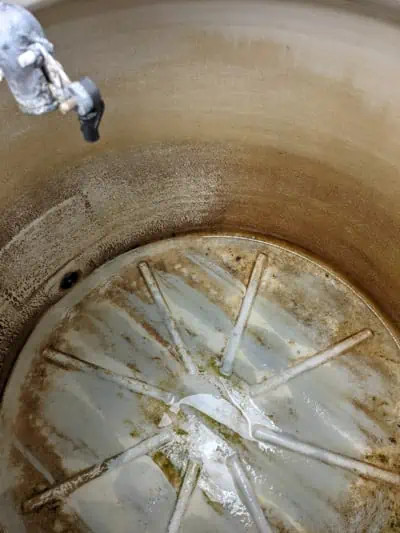 Inside a Tinaco water tank
Inside a Tinaco water tank
2. Do Local People Drink Tap Water?
No, most people who live in Mexico do not drink tap water. Mexico has the highest rate of private bottled water consumption in the world, and a good deal of plastic waste because of it. According to research, Mexico consumes more bottled water per capita than any other nation, highlighting concerns for waste management and alternative solutions.
While there are some circumstances like living off the grid may have safe access to well water or natural springs, however, this isn’t common. Sometimes it is abject poverty that requires citizens to drink whatever water is available. The vast majority of the population does not trust the water coming out of the tap to be fit for human consumption. This lack of trust is a significant factor in the widespread use of bottled water.
Many parts of Mexico are notorious for hard water with a heavy mineral content. Limescale or hard water deposits collect on the faucets and stop up the showerheads. Those minerals can harm pet animals and cause kidney problems. Many people in Mexico won’t even give their pets water from the tap.
In emergency situations, it is possible to boil water to make it safe for human consumption. It will still taste bad, but the temperature kills the bacteria and viruses that could cause you harm. Boiling water is a practical method to ensure it is safe for consumption during emergencies.
Most people who move to Mexico are surprised by the network of bottled water salespeople that distribute water throughout the city. They will set the heavy five-gallon jugs into a water dispenser and change it out a couple of times a week. This delivery system is a common sight and provides a convenient way for residents to access safe drinking water.
Bottled water is relatively inexpensive and tastes so much better than the water that comes out of the tap. The availability and affordability of bottled water make it a popular choice for most people in Mexico.
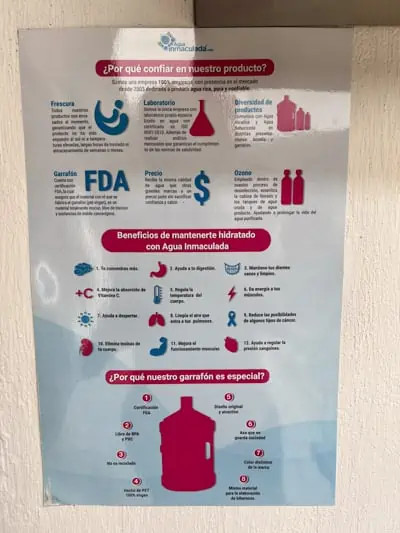 Water filtration guarantee
Water filtration guarantee
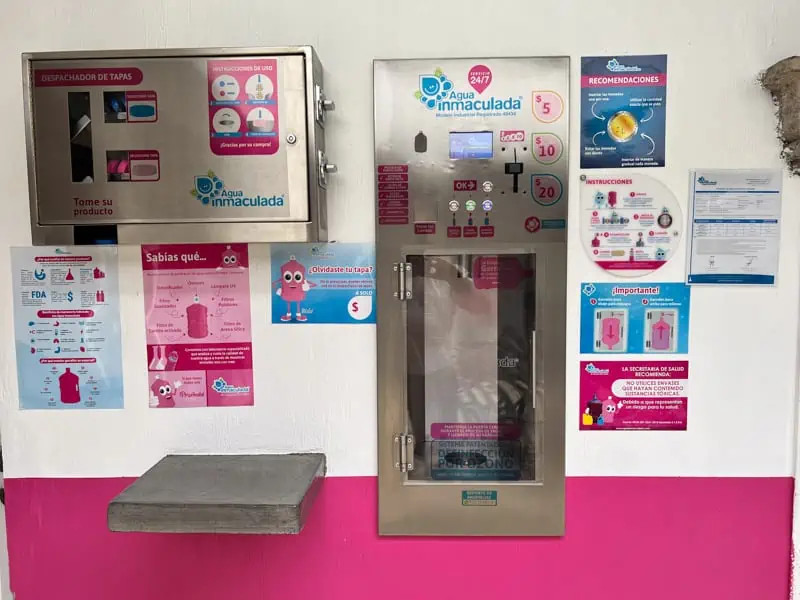 Water filtration stand
Water filtration stand
3. Do Mexican Houses Have Filtration Systems?
Yes, it is very common for houses to have basic filtration systems that remove some sediment. These filters need to be changed every six months, or they get really dirty. Regular filter replacement is crucial for maintaining the effectiveness of these systems.
It is much less common for houses to install advanced filtration systems on the water they will drink. It is less common for all of the house’s water to pass through an expensive water filtration system. Advanced filtration systems offer a higher level of purification but are less frequently used due to cost and complexity.
Filtration systems for drinking water need multiple (like six) stages of filtration, reverse osmosis, and UV light disinfection. They are complicated systems that require monthly maintenance by professionals. These systems are comprehensive and designed to provide the safest drinking water possible.
People installing water filtration systems do not want to use 5-gallon jugs because they are so heavy to lift. The inconvenience of lifting heavy jugs is a motivator for installing filtration systems.
Professional water filtration systems start at around $500 pesos per month. While these systems can be costly, they provide a convenient and reliable source of purified water.
The taste of purified water can sometimes be different from bottled water brands like Agua Ciel or Bonafont. One of the reasons that San Pellegrino tastes so good is its unique mineral content. If you strip out all the minerals without replacing the correct balance, the water tastes funny. Maintaining a balance of minerals is essential for good taste.
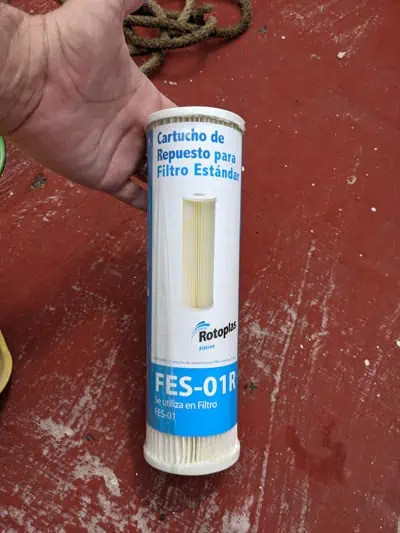 Water filter
Water filter
4. Where Can You Buy A Bottle of Water In Mexico?
Bottled water is sold nearly everywhere in Mexico. There are tons of different-sized bottles, but the most common is the returnable 5-gallon (20-liter) jug. The widespread availability of bottled water makes it easy to stay hydrated and safe.
5-gallon jugs can be returned to the Oxxo for a new one. There are usually at least two companies supplying each Oxxo with water. Returning jugs is an environmentally friendly option that reduces plastic waste.
Supermarkets, grocery stores, pharmacies, convenience stores (abarotes), and tons of other retailers sell water. Water is easily accessible at various retail locations.
There are water kiosks set up all over my neighborhood where you can put some coins into a machine and fill up a jug with either normal water or alkaline water. There is a water kiosk behind my favorite taco shop, so I can kill two birds with one stone (matar dos pajaros con un tiro). Water kiosks offer a convenient and affordable way to refill water containers.
The best place to buy water is from the Waterman. In my neighborhood, we have at least four different companies that come by several days a week to sell water. These delivery services provide water directly to your doorstep.
I buy Agua Ciel (the best bottled water, in my opinion) from the Coca-Cola Company. They sell soft drinks, sparkling water (Topo Chico and Agua Ciel), and Santa Clara milk. I tip them a few pesos each time they visit, and they leave my 5-gallon jugs in the water dispenser. Building a relationship with your water delivery person can be a pleasant experience.
The water from the major companies tastes better than the tap water I grew up with back home, and I have never gotten sick from it. If a 5-gallon jug is damaged in any way, they exchange it, no questions asked. Major companies prioritize customer satisfaction and safety.
I have come to love my bottled water and the fact there is a milkman to deliver it. Every time we go back to San Diego, I have to buy purified water because the taste of the tap water discourages me from drinking the amount of water that is healthy. Having access to good-tasting water encourages healthy hydration habits.
You can even get in the habit of buying the gourmet ice. When it is hot, there is nothing more luxurious than a tumbler full of ice water. Enjoying gourmet ice is a simple pleasure that can enhance your drinking experience.
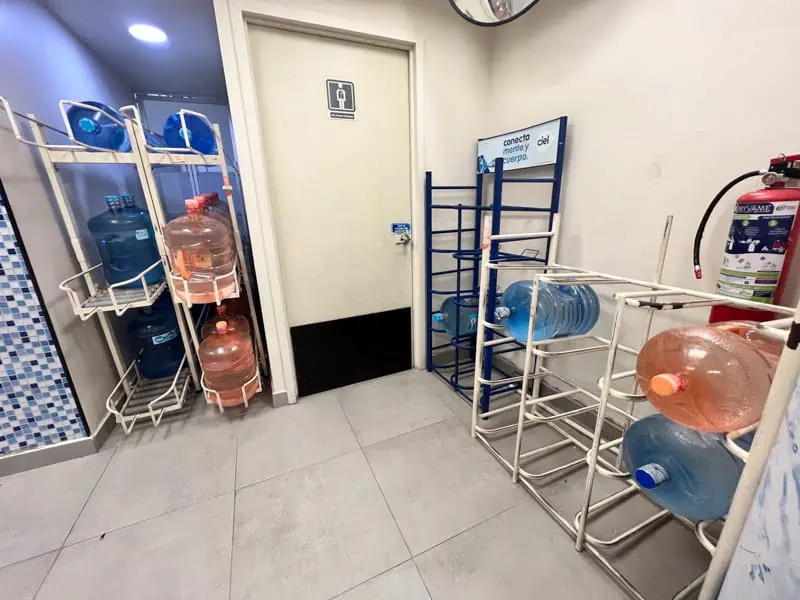 Water jugs for sale at Oxxo
Water jugs for sale at Oxxo
5. Will Ice Make Me Sick in Mexico?
This is where things get a little more complicated in Mexico. It is not common for restaurants to make their own ice. Successful restaurants almost exclusively purchase their ice from reputable ice makers that use purified water. Reputable restaurants prioritize customer safety by using purified water for ice.
The best restaurants in Guadalajara would never consider using tap water in their ice or their drinks because people are going to get sick and they will not come back. The clearest sign that a restaurant is following basic sanitary standards is that there are a lot of people eating there. A busy restaurant is often a good indicator of quality and hygiene.
While I am sure that there are cases of restaurants using tap water when they should be using purified water but that is not common. No successful restaurant is going to cut corners on purified water in order to save money. Sick and unhappy customers are way more expensive in the long run. The cost of losing customers due to illness outweighs any savings from using tap water.
In 2022, there were images all over the news of a street vendor filling up buckets that made it look like he was going to use dirty water to make aguas frescas. There were no pictures of him actually mixing dirty water into food products, the internet went mad. He could have been using that water to clean something, but people didn’t want to take a chance. Vigilance is key when it comes to street food vendors.
Be cautious about buying food from street vendors that do not take basic hygiene seriously. At a minimum, a street vendor should have access to a place to wash their hands. Basic hygiene practices are essential for safe street food consumption.
I eat street food all the time, but I look for famous, busy street food stands that people return to often. I don’t want to buy aguas frescas from a dude who doesn’t have access to a bathroom or a place to wash his hands. Choosing popular and hygienic street food vendors minimizes risk.
While it is not common to see dirty water used in food service, it is important to always be on the lookout. In 2020, there was a story circulating around social media of a group of young women who found pills frozen into their ice cubes at a nightclub. Don’t let your guard down. Staying alert and cautious is always a good practice.
6. Can I Make Coffee With Tap Water In Mexico?
No, don’t make coffee with tap water. Number 1, tap water tastes horrible and will ruin good coffee. The poor taste of tap water will negatively impact the flavor of your coffee.
Number 2, the ideal temperature for making coffee is way below boiling. If the water is contaminated, simply warming it will not kill all the bacteria. Water must reach boiling temperature and sustain that temperature for at least one minute to kill all the potential pathogens. Boiling water is essential to eliminate harmful bacteria and pathogens.
7. Can I Brush My Teeth With Tap Water In Mexico?
Yes, as long as you do not swallow the water. Most adults are able to brush their teeth without swallowing the toothpaste water. Little kids find it a lot harder. If you can avoid swallowing, brushing with tap water is generally safe.
If you are just arriving in Mexico or have little kids, try to use bottled water to brush your teeth. You honestly never know what the maintenance schedule looks like at the hotel or house you are staying at. Using bottled water is a safer option, especially for children and new arrivals.
Once you get your own place and have paid someone to scrub out the Tinaco, you know that the water is clean. Until you have seen the Tinaco, you don’t know if the water is clean. Knowing the maintenance history of your water source provides peace of mind.
8. Can I Drink Tap Water In A Hotel Room In Mexico?
No, do not drink the tap water in a hotel. Hotels provide at least a small amount of bottled water for each room. Additionally, the hotel will have 5-gallon jugs around somewhere. Hotels typically offer safe alternatives to tap water for guests.
I always carry a reusable water bottle, an insulated tumbler with a top, that I can refill. I hate buying single-use plastic bottles of water because I can always fill up my water bottle at a hotel or restaurant. Carrying a reusable water bottle is an eco-friendly and convenient practice.
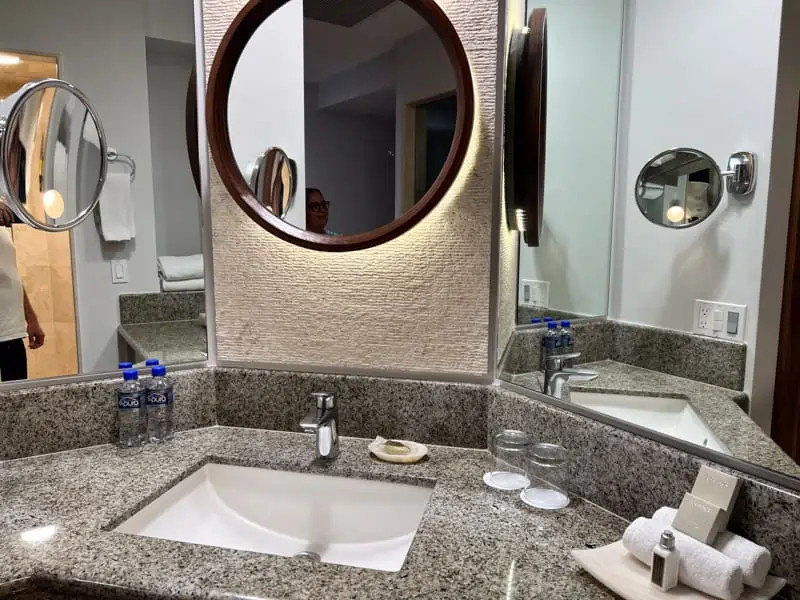 Do not drink hotel tap water in Mexico
Do not drink hotel tap water in Mexico
9. Do Restaurants In Mexico Serve Tap Water to Customers?
No, serving a glass of tap water to customers is a good way to go out of business. Sick customers do not return. Restaurants avoid serving tap water to prevent customer illness and maintain their reputation.
It is common for waiters to try and upsell customers to purchase bottles of water. If a customer asks for a glass of water, it will almost always come from a 5-gallon jug. Serving tap water is either malicious or ignorant. Restaurants do not want to get a reputation for making their customers sick. Upselling bottled water ensures customer safety and satisfaction.
10. Final Thoughts On Why You Can’t Drink Tap Water In Mexico
Mexico’s tap water can be problematic. To be on the safe side, it is best to avoid drinking tap water until you have evaluated the local water supply, the city-wide water distribution system, and the local water storage system. Things like old pipes or a dirty storage tank can contaminate water sources. Taking precautions is essential for ensuring your safety and health.
While some major cities like Puerto Vallarta have an improved water supply, you have no clue if smaller hotels are taking all the necessary precautions to keep that water clean and drinkable. Even in cities with improved water supplies, vigilance is necessary.
The best way to make sure you are consuming safe water is to carry your own water bottle and fill it up from a 5-gallon jug of purified water. You can buy bottled water at every corner store, but try to minimize the single-use plastics by using a refillable water bottle. Carrying a refillable water bottle is a practical and eco-friendly solution.
11. FAQ
1. Is it safe for tourists to drink tap water in Mexico?
No, it is generally not safe for tourists to drink tap water in Mexico due to potential contamination. It’s best to stick to bottled or purified water.
2. What are the common contaminants found in Mexican tap water?
Common contaminants include bacteria, viruses, parasites, and heavy metals.
3. Can boiling tap water make it safe to drink in Mexico?
Boiling tap water for at least one minute can kill bacteria and viruses, but it won’t remove heavy metals or other chemical contaminants.
4. Are there any cities in Mexico where tap water is safe to drink?
While some major cities like Puerto Vallarta have improved water treatment, it is still generally recommended to avoid drinking tap water.
5. What are the best alternatives to tap water in Mexico?
The best alternatives include bottled water, purified water from 5-gallon jugs, and using water filtration systems.
6. How can I ensure the ice in my drink is safe in Mexico?
Choose restaurants that are popular and appear clean, as they are more likely to use purified water for ice.
7. Is it safe to brush my teeth with tap water in Mexico?
It is generally safe to brush your teeth with tap water as long as you avoid swallowing it.
8. What should I do if I accidentally drink tap water in Mexico?
Monitor yourself for symptoms like diarrhea, nausea, or stomach cramps. If symptoms persist, seek medical attention.
9. Do hotels in Mexico provide safe drinking water for guests?
Yes, most hotels provide bottled water or have 5-gallon jugs available for guests to refill their water bottles.
10. Are water filtration systems in Mexican homes reliable?
Basic filtration systems are common, but advanced systems with multiple stages of filtration, reverse osmosis, and UV light disinfection are less common. Regular maintenance is crucial for their effectiveness.
We at gaymexico.net understand the importance of reliable information, especially for the LGBTQ+ community. That’s why we encourage you to explore our website for comprehensive travel guides, safe LGBTQ+ spaces, and the latest updates to ensure a memorable and secure trip. From vibrant cultural events to supportive local communities, Mexico offers a wealth of experiences for everyone.
Ready to plan your adventure? Visit gaymexico.net now and discover a welcoming and informed community ready to help you make the most of your journey. For further information, you can reach us at Address: 3255 Wilshire Blvd, Los Angeles, CA 90010, United States. Phone: +1 (213) 380-2177 or visit our website gaymexico.net.